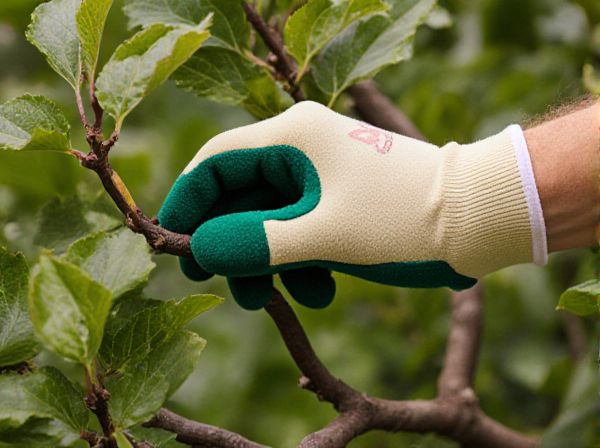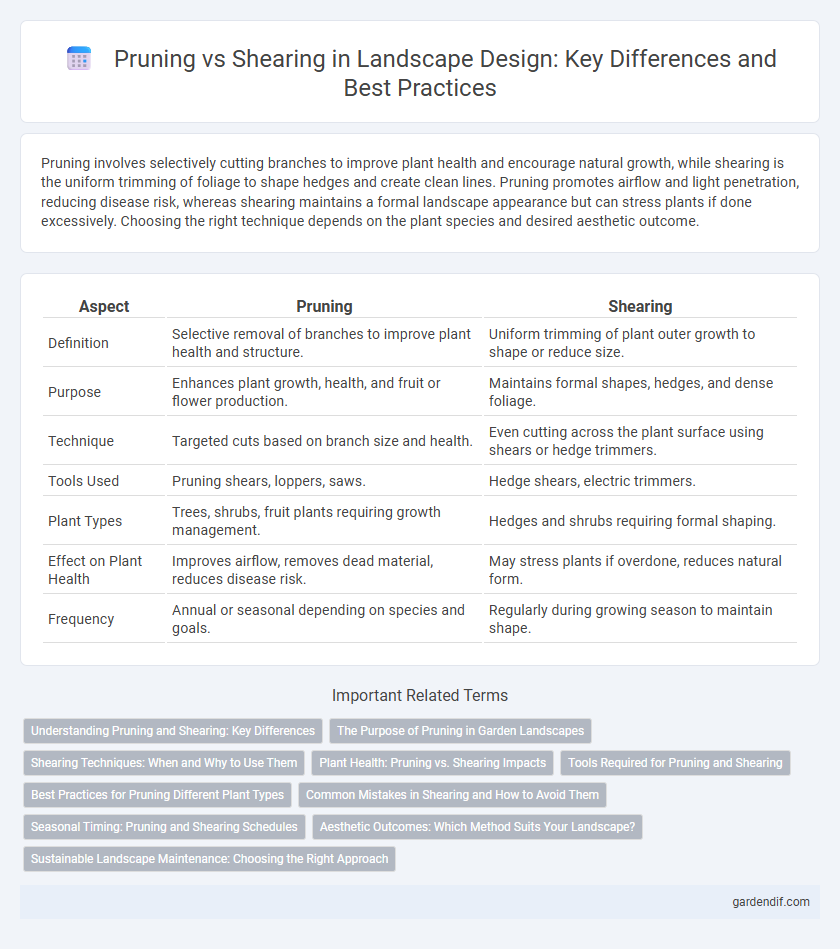
pruning vs shearing Illustration
Pruning involves selectively cutting branches to improve plant health and encourage natural growth, while shearing is the uniform trimming of foliage to shape hedges and create clean lines. Pruning promotes airflow and light penetration, reducing disease risk, whereas shearing maintains a formal landscape appearance but can stress plants if done excessively. Choosing the right technique depends on the plant species and desired aesthetic outcome.
Table of Comparison
| Aspect | Pruning | Shearing |
|---|---|---|
| Definition | Selective removal of branches to improve plant health and structure. | Uniform trimming of plant outer growth to shape or reduce size. |
| Purpose | Enhances plant growth, health, and fruit or flower production. | Maintains formal shapes, hedges, and dense foliage. |
| Technique | Targeted cuts based on branch size and health. | Even cutting across the plant surface using shears or hedge trimmers. |
| Tools Used | Pruning shears, loppers, saws. | Hedge shears, electric trimmers. |
| Plant Types | Trees, shrubs, fruit plants requiring growth management. | Hedges and shrubs requiring formal shaping. |
| Effect on Plant Health | Improves airflow, removes dead material, reduces disease risk. | May stress plants if overdone, reduces natural form. |
| Frequency | Annual or seasonal depending on species and goals. | Regularly during growing season to maintain shape. |
Understanding Pruning and Shearing: Key Differences
Pruning involves selectively removing specific branches or stems to improve plant health, shape, and growth, focusing on cutting at precise points to encourage natural development. Shearing is the uniform trimming of plant surfaces, primarily for shaping hedges or topiaries, creating a clean, manicured appearance but potentially stressing the plant if overdone. Understanding the key differences between pruning and shearing helps maintain optimal plant health and landscape aesthetics by applying the right technique for each species and design goal.
The Purpose of Pruning in Garden Landscapes
Pruning enhances plant health by removing dead, damaged, or diseased branches, promoting air circulation and light penetration within the canopy. It shapes plants to maintain natural growth patterns, encouraging stronger structure and more abundant flowering or fruiting. Unlike shearing, which focuses on uniform shape and dense growth, pruning supports long-term vitality and aesthetic appeal in garden landscapes.
Shearing Techniques: When and Why to Use Them
Shearing techniques in landscaping are ideal for creating formal hedges and topiaries due to their ability to produce smooth, uniform shapes. This method is effective when maintaining precise geometric designs or dense foliage, as it encourages dense growth along the trimmed edges. Shearing is best used on evergreen shrubs like boxwood and privet, where controlled shaping enhances the aesthetic appeal without compromising plant health.
Plant Health: Pruning vs. Shearing Impacts
Pruning selectively removes dead or diseased branches, improving air circulation and reducing pest infestation, which promotes overall plant health and growth vigor. Shearing, by contrast, involves uniform cutting of foliage that can stress plants, leading to weakened structure and increased susceptibility to disease. Proper pruning techniques support long-term vitality, while excessive shearing can cause dense, unhealthy growth prone to decline.
Tools Required for Pruning and Shearing
Pruning requires precise tools such as bypass pruners, loppers, and pruning saws to selectively remove branches and promote healthy plant growth. Shearing typically involves hedge trimmers or electric trimmers designed for uniform shaping and maintaining dense foliage. Choosing the right tool enhances efficiency and plant health by matching the task's specific cutting needs.
Best Practices for Pruning Different Plant Types
Pruning techniques vary significantly depending on plant type; hardwood trees benefit from selective branch removal to promote airflow and structural integrity, while flowering shrubs require precise cuts just above buds to encourage blooming. Shearing is best reserved for formal hedges and topiary where uniform shape is desired, but overusing this method on diverse plant species can inhibit natural growth and reduce plant health. Employing species-specific pruning schedules and tools enhances plant vigor, optimizes aesthetics, and reduces disease risk in landscape management.
Common Mistakes in Shearing and How to Avoid Them
Common mistakes in shearing include cutting too deeply, which damages the plant's health by exposing inner wood, and shaping indiscriminately, leading to unnatural or stunted growth. Avoid these errors by using sharp shears, maintaining consistent, light cuts, and following the plant's natural form to promote healthy development. Regularly sterilizing tools reduces the risk of disease transmission during shearing, ensuring optimal landscape maintenance.
Seasonal Timing: Pruning and Shearing Schedules
Pruning is typically done during late winter or early spring to remove dead or diseased branches and encourage healthy new growth, while shearing is best performed in late spring and summer to maintain shape and density. Proper seasonal timing helps promote plant health by preventing stress and allowing adequate time for recovery. Different plant species may require specific schedules, so consulting local guidelines ensures optimal pruning and shearing results.
Aesthetic Outcomes: Which Method Suits Your Landscape?
Pruning enhances the natural form and health of trees and shrubs by selectively removing branches, promoting a more organic aesthetic that complements diverse landscape designs. Shearing creates uniform, dense shapes best suited for formal hedges and topiaries, providing a clean, structured appearance but potentially limiting natural growth patterns. Choosing between pruning and shearing depends on whether the desired landscape aesthetic favors natural, irregular forms or precise, manicured shapes.
Sustainable Landscape Maintenance: Choosing the Right Approach
Pruning promotes sustainable landscape maintenance by focusing on plant health through selective removal of branches, which improves airflow and reduces disease risk. Shearing, often used for shaping hedges, can stress plants and lead to denser growth that requires more frequent maintenance and resources. Choosing pruning over shearing supports long-term plant vitality and reduces environmental impact by minimizing chemical use and water consumption.
pruning vs shearing Infographic

 gardendif.com
gardendif.com